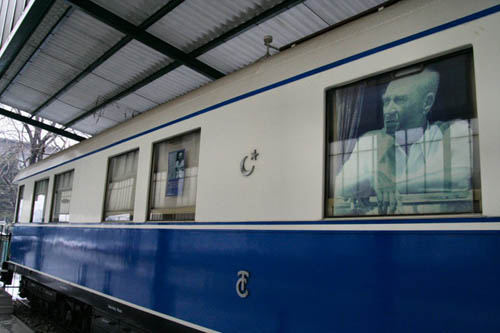A train trip with Ataturk
Support this magazine and radio show, today.

Just five bucks!
|


|
Francesco Martinelli takes
A Train Trip with Atatürk

This is the starting point for a CD which
allows a fascinating glimpse into the early years of the Presidential orchestra,
poised between the celebration of Ottoman classical tradition and the necessary
innovation - Atatürk`le Bir Tren Yolculuğu -
Yaver Şu Sevdiğim Şarkıyı Çal”(A train trip with
Atatürk - Attendant, play me that song I love).
The burning gazel sung by
Hafız Yasar Bey contrasts with the elegant vocal lines of Münir Nurettin
Selçuk; the stately mahur beste by
Hamamizade Ismail Dede Efendi with the symphonic arrangement of a pesrev by Giriftzen Asım Bey; longing Rumeli Türküleri sung by small choirs in spontaneous arrangements or by the intense Safiye Ayla stand
side by side with nostalgic operetta arias and romantic Turkish tangos. A
powerful early recording by Müzeyyen Senar, recently celebrated in the "Crossing the bridge movie, explains her
status in Turkish music, while art music composers like Bimen Şen and Haşim
Bey represent different styles.
 The three final tracks provide a glorious closing: an instrumental zeybek on tambura by Osman Pehlivan, a beautiful nefes (hymn) from the tradition of the Bektaşi Sufi brotherhood, its
rhythm reminiscent of the typical measured steps of the sema and typically sung by a male/female duet. Atatürk loved
Bektasi songs and dances, often asked for them to be performed. And finally,
the only Arabic and the rarest record in the collection, by obscure kanunist
Nubar Bey, on Lebanese Baidaphone; hitherto unknown, it's a brilliant taksim. Pity that the notes by Cemal
Ünlü, the major expert of early Turkish recordings, are not translated, and
digital denoising of the sound is applied too harshly and in a wildly different
manner track from track.
The three final tracks provide a glorious closing: an instrumental zeybek on tambura by Osman Pehlivan, a beautiful nefes (hymn) from the tradition of the Bektaşi Sufi brotherhood, its
rhythm reminiscent of the typical measured steps of the sema and typically sung by a male/female duet. Atatürk loved
Bektasi songs and dances, often asked for them to be performed. And finally,
the only Arabic and the rarest record in the collection, by obscure kanunist
Nubar Bey, on Lebanese Baidaphone; hitherto unknown, it's a brilliant taksim. Pity that the notes by Cemal
Ünlü, the major expert of early Turkish recordings, are not translated, and
digital denoising of the sound is applied too harshly and in a wildly different
manner track from track.
Thanks to the museum director, Mrs. Servet Sarıaslan,
I received a complete list of the collection. What was left out from the issued
CD is just as interesting as the pieces published. Atatürk's preference for
Safiye Ayla's voice is confirmed, with more than ten records. His love for
opera represented by Traviata recordings with Amelita Galli-Curci - a fine choice - and fantasies on Verdi's
themes; modern dances like fox-trot and tangos are well represented.
The most obvious absence is religious music. Atatürk declared himself a Muslim, but in
his less guarded moments confessed an aversion for all forms of organized
worship. There is a ney taksim, but it is performed by Neyzen Tevfik, a provocative
intellectual who insulted as many sacred cows as possible, in the very
tradition of the Sufi saints, presenting himself thus: "Neyzen Tevfik, whose
three-dimensionality is manifested in his music, his poetry, and his rakı .
Even more significant are the three Greek records Atatürk was travelling with,
less than 15 years after the bloodshed, in a time when Venizelos proposed him
for the Nobel Peace prize: a tango, and two 78s by Roza Eskenazi, the
Istanbul-born Greek-Jewish singer, one of the originators of rebetiko, among them "Trava [Manga] Re
Alani / The manga hit the road," a travel song if ever there was one. - Francesco Martinelli
CD info: Atatürk`le Bir Tren Yolculuğu -
Yaver Şu Sevdiğim Şarkıyı Çal” / A train trip with
Atatürk - Attendant, play me that song I love STR productions - 2006
The Museum of the Turkish Republic Railways (TCDD Müzesi ve Sanat Galerisi) is by the Ankara
Train Station, Talatpaşa Bulvarı, Ulus, and can be visited free of
charge every day but Saturdays, Sundays and holiday days. Website.
Looking for More Information?



© 2006 RootsWorld. No reproduction of any part of this page or its associated files is permitted without express written permission.
|






 The three final tracks provide a glorious closing: an instrumental zeybek on tambura by Osman Pehlivan, a beautiful nefes (hymn) from the tradition of the Bektaşi Sufi brotherhood, its
rhythm reminiscent of the typical measured steps of the
The three final tracks provide a glorious closing: an instrumental zeybek on tambura by Osman Pehlivan, a beautiful nefes (hymn) from the tradition of the Bektaşi Sufi brotherhood, its
rhythm reminiscent of the typical measured steps of the 